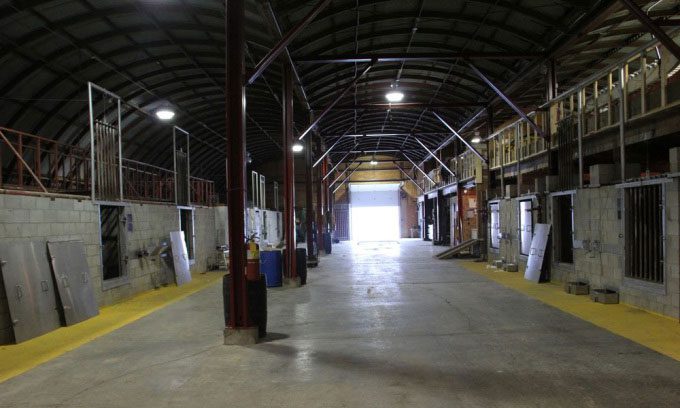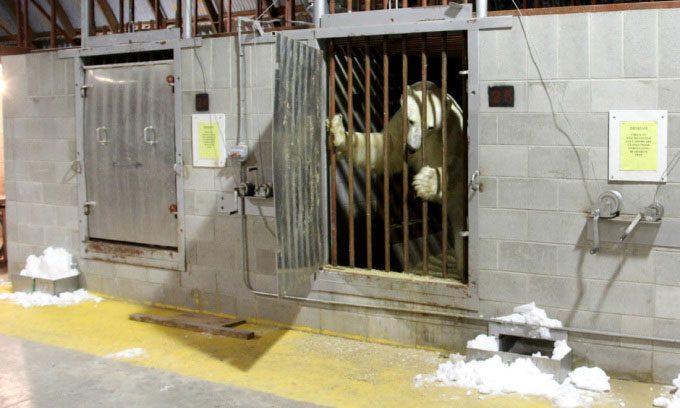The Polar Bear Holding Facility has 28 cells, but it is not designed to punish “bad” bears; rather, it aims to protect both the bears and humans.
Churchill, located in Manitoba, Canada, is known as the “polar bear capital of the world.” This is the only town where humans and polar bears live in close proximity and the only town with a “jail” specifically for this species, as reported by Business Insider on May 13. This unique facility is called the Polar Bear Holding Facility.

Tourists observing polar bears from a vehicle. (Photo: Aceshot1/Amusing Planet).
Churchill is located at the edge of the Arctic, with a population of about 900 people, roughly the same number of polar bears living on the ice at nearby Hudson Bay. At the end of July each year, polar bears leave the melting ice to spend the summer at Wapusk National Park. Churchill is situated between these two locations and has become a common area for polar bears to frequent. In October and November, as the ice begins to form again, they return to hunt seals.
To keep residents and tourists safe from encounters with polar bears—the largest land predators on the planet—the town of Churchill has implemented a unique Polar Bear Alert Program, according to Chantal Cadger Maclean, a conservation officer for the program.
By autumn, polar bears are very hungry and ready to eat almost anything. Consequently, they often appear near or in Churchill during the first three weeks of November. “At the beginning of the year, they are fat and happy from eating seals, so they are not actively looking for food. However, they are opportunistic predators. Therefore, if something is around, they will eat it,” Maclean explained.
“Something” typically refers to improperly covered waste. Humans are usually not on the polar bear’s menu. However, if they become too hungry, they will not be picky. Since bears coming into town pose a risk of encounters and danger to people, conservation officers often work to quickly and safely drive them out of town.

Inside the polar bear jail. (Photo: Province of Manitoba).
Polar bears have many opportunities to leave town before being trapped and taken to the jail. Whenever a call is received, the conservation officers of the Polar Bear Alert Program immediately drop what they are doing and rush to the location. They use various whistles and sound devices to scare the bears away from Churchill. Helicopter teams can also spot bears hiding among the rocks and guide them away from the town.
Bears are very sensitive to loud noises, so this method is often effective, although sometimes conservation officers have to resort to additional physical deterrents like rubber bullets or paintball guns. However, some bears are not afraid of humans and refuse to leave. Additionally, bears that have associated humans with food may return to rummage through trash. These bears would need to be taken to the Polar Bear Holding Facility. Thanks to the success of the Polar Bear Alert Program, euthanasia (humane killing) of polar bears is now very rare.
To bring polar bears to the jail, conservation officers need to capture them, usually by either using a tranquilizer gun with Telazol to immobilize them or by setting traps baited with seal meat. They then transport the polar bears to one of the 28 cells at the facility. There are large cells for mother bears and their cubs, air-conditioned cells for hot weather, and single cells.

Polar bears inside the special holding facility. (Photo: Province of Manitoba)
Conservation officers will measure the bears and attach ear tags for tracking. The “prisoners” will stay at the facility for 30 days or until the ice forms on Hudson Bay, whichever comes first.
“If there is enough ice on the bay to drive a truck carrying bears, we will release them, and we will typically never see them again. If not, the bears will be released by helicopter along the coastline, far from the town,” Maclean stated.
At the Polar Bear Holding Facility, the “prisoners” are not fed but still have access to water and snow. According to Maclean, feeding the bears would cause them to associate food with humans, increasing the risk of them returning to town. Moreover, fasting does not harm the bears as they rely on fat reserves built up over the summer and typically do not eat. The goal of this process is to provide them with an experience they do not want to repeat.
The Polar Bear Alert Program aims to protect both bears and humans. The Polar Bear Holding Facility is not a punishment for “bad” bears. “They are not bad at all. They are just trying to do what bears do—walk on ice and survive,” Maclean shared.
However, as global climate warms and sea ice diminishes, bears are increasingly likely to approach humans in search of food, posing dangers to both. The Polar Bear Alert Program helps to manage rather than kill bears—a practice that was common before the program was implemented in the late 1960s. Since 1983, there have been no fatal polar bear attacks in Churchill.


















































